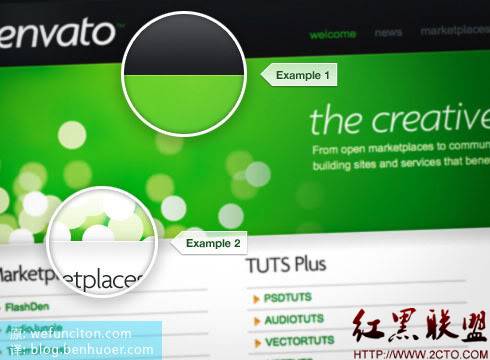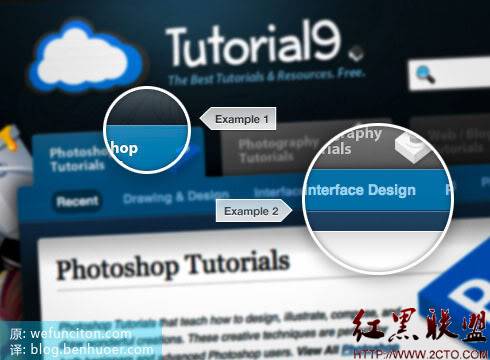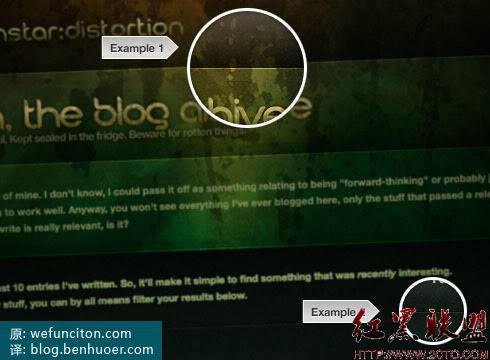High-Quality Web Design: Examples and Tips 2 (Pixel Perfect)
There is a way to tell if someone really put their heart into a web design. Sometimes it’s the little details that create miracles, details that are barely noticeable to others. What I mean by "pixel-perfect" is careful attention to lines, edges, and border strokes. Instead of just using a single line, add a few more details. Detail can be a subtle gradient, or it can be as little as a thin 1-pixel-wide line (used to represent shadows or highlights). With these details, your design will be completely different. Some designers are particularly good at this: Collis Ta'eed, David Leggett and Wolfgang Bartelme. ), the green content box has a brighter green line around the edge. In Example 2, there is a soft gradient shadow on the edge of the block, and there is a one-pixel white stroke on the edge. This is a very clever approach, using shadows to emphasize the highlights. The green area behind has a very soft and subtle light and shadow effect, which helps draw attention to the crisp and crisp details in the white area below. While these practices don't always make your designs look more polished, they do help you give your designs a three-dimensional feel. The design elements then become gems embedded on the page, rather than a lifeless piece of paper laid flat on top.
David Leggett has a great understanding of how to make single pixel top bars. His recently redesigned tutorial9 is a collection of great pixelation techniques. You can see in Example 1 how he made the navigation label more textured simply by adding a 1-pixel highlight. Example 2 uses more techniques. The camera icon's shadow, the shadow and highlight of the white area below, and the 1-pixel highlight on the navigation bar. 
This beautiful navigation menu, created by Ryan Scherf, uses pixel-perfect detail to enhance the design Excellent example of quality. The red buttons have a 1-pixel highlight, and the dividing lines between links have the same quality and detail. As you can see, he wasn’t content with just a gray line dividing it, Ryan also added a 1 pixel wide highlight line underneath to prevent the design from looking too flat. 
Translation note: Grunge styles include "old", "psychedelic rock", "dirty", etc. There are several layers of meaning in it, and it can be regarded as a genre in graphic art. 
To achieve perfection in this technique, continuous practice is particularly important. As you can see, something as simple as a 1 pixel line can add a really cool sense of depth to a design. You don't even have to use those bevels or gradients, go to all the trouble of actually placing them on something. 
Small details are the key to perfecting the sense of content.
Think about pixel-level issues
Strokes, gradients, lines, shadows, etc., can effectively enhance the design without being too wide
Before and after comparison
Be careful to compare after applying the effect with before without this effect. So you can know what changes these details have brought
The above is the content of High-Quality Web Design: Examples and Techniques 2 (Pixel-Level Perfection). For more related content, please pay attention to the PHP Chinese website (www.php.cn)!

Hot AI Tools

Undresser.AI Undress
AI-powered app for creating realistic nude photos

AI Clothes Remover
Online AI tool for removing clothes from photos.

Undress AI Tool
Undress images for free

Clothoff.io
AI clothes remover

Video Face Swap
Swap faces in any video effortlessly with our completely free AI face swap tool!

Hot Article

Hot Tools

Notepad++7.3.1
Easy-to-use and free code editor

SublimeText3 Chinese version
Chinese version, very easy to use

Zend Studio 13.0.1
Powerful PHP integrated development environment

Dreamweaver CS6
Visual web development tools

SublimeText3 Mac version
God-level code editing software (SublimeText3)

Hot Topics
 1386
1386
 52
52
 Revealing the unique advantages of absolute positioning in web design
Jan 23, 2024 am 08:16 AM
Revealing the unique advantages of absolute positioning in web design
Jan 23, 2024 am 08:16 AM
Explore the unique advantages of absolute positioning in web design. In web design, absolute positioning is a commonly used layout method. By using absolute positioning, elements can be placed precisely at specified locations on the web page, and some special layout effects can be easily achieved. This article explores these advantages and illustrates them with specific code examples. Precise positioning of elements Absolute positioning allows precise control of the position of elements on a web page. By specifying the top, right, bottom, and left attributes of the element, the element can be
 CSS3 animation brings creative inspiration and unlimited possibilities to web designers
Sep 09, 2023 pm 08:45 PM
CSS3 animation brings creative inspiration and unlimited possibilities to web designers
Sep 09, 2023 pm 08:45 PM
Overview of the creative inspiration and unlimited possibilities that CSS3 animation brings to web designers: In modern web design, animation effects have become an important factor in improving user experience and increasing website attractiveness. The emergence of CSS3 animation technology has brought more flexible, rich and creative design options to web designers. This article will explore the creative inspiration and unlimited possibilities that CSS3 animation brings to web designers, and provide some code examples. 1. Basic concepts and syntax of CSS3 animation. Before introducing CSS3 animation, we first need to
 Web design skills and practical experience sharing based on CSS3
Sep 08, 2023 pm 07:07 PM
Web design skills and practical experience sharing based on CSS3
Sep 08, 2023 pm 07:07 PM
Sharing of web design skills and practical experience based on CSS3 In today's Internet era, web design is becoming more and more important. With the advent of CSS3, designers can now use a variety of stunning effects to engage users. This article will share some web design skills and practical experience based on CSS3, aiming to help readers improve their web design level. 1. Use transition effects. Transition effects can produce smooth animation effects for elements from one state to another. By using the CSS3 transition property, we can
 Study the impact of introducing CSS third-party frameworks on web design
Jan 16, 2024 am 10:32 AM
Study the impact of introducing CSS third-party frameworks on web design
Jan 16, 2024 am 10:32 AM
Exploring the impact of the introduction of third-party frameworks into CSS on web design Introduction: With the rapid development of the Internet, web design has become increasingly important. In order to improve user experience and provide richer functions, developers often need to use third-party frameworks to assist design and development. This article will explore the impact of introducing CSS third-party frameworks on web design and give specific code examples. 1. What is CSS third-party framework? CSS third-party framework is a set of predefined CSS styles and components that can be called directly when building a web page. These frameworks are rich in content,
 Application fields of element selectors in web design
Jan 13, 2024 am 10:35 AM
Application fields of element selectors in web design
Jan 13, 2024 am 10:35 AM
The application of element selectors in web design requires specific code examples. In web design, element selectors are a very important CSS selector, which can help us control and adjust the styles of elements in web pages. By flexibly using element selectors, various exquisite web design effects can be achieved. 1. Basic syntax and usage of element selectors The element selector is the simplest type of CSS selector. It selects the corresponding element by specifying the tag name of the HTML element. The basic syntax of the element selector is: tag name {
 How to use CSS Positions layout to design card layout for web pages
Sep 28, 2023 am 08:17 AM
How to use CSS Positions layout to design card layout for web pages
Sep 28, 2023 am 08:17 AM
How to use CSSPositions layout to design card layout for web pages. In web design, card layout is a common and popular design method. It divides the content into independent cards, each card contains certain information, and can easily create a neat and layered page effect. In this article, we will introduce how to use CSSPositions layout to design the card layout of a web page, and attach specific code examples. Create the HTML structure First, we need to create the HTML structure to represent the card layout.
 What does h5 look like?
Apr 01, 2025 pm 05:29 PM
What does h5 look like?
Apr 01, 2025 pm 05:29 PM
HTML5 (h5) is the fifth version of HTML, designed to enhance the flexibility and functionality of web development. The main features of h5 include: 1) new semantic tags, such as, et al.; 2) embedded audio and video support, such as, et al.; 3) Canvas drawing API; 4) Geolocation API. These features are implemented through the browser's JavaScript engine, making web pages more dynamic and interactive.
 How to use CSS3 technology to create cool web page effects
Sep 11, 2023 pm 12:54 PM
How to use CSS3 technology to create cool web page effects
Sep 11, 2023 pm 12:54 PM
How to use CSS3 technology to create cool web page effects. With the development of the Internet, web design is becoming more and more important. The emergence of CSS3 technology has brought more inspiration and creative space to web designers. CSS3 has rich features and effects, which can easily achieve cool web page effects. This article will introduce some commonly used CSS3 features, and use examples to show how to use these features to create cool web page effects. Border effect Border is a common element in web design. Through the border feature of CSS3, you can add more effects to the border.




